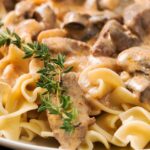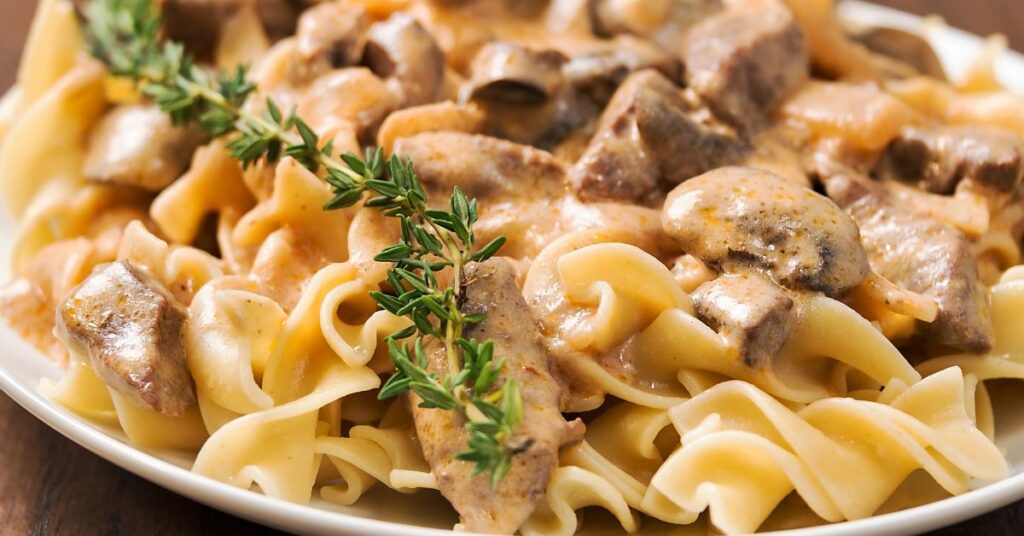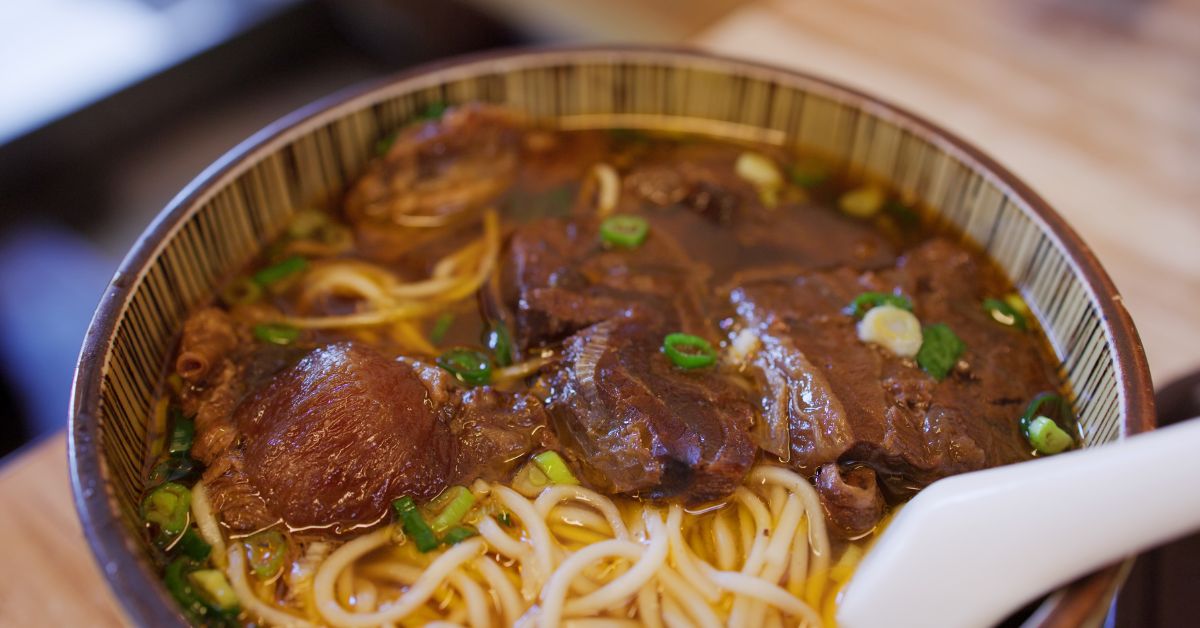Easy Beef and Noodles is more than just a dish; it’s a comforting embrace in the form of food. Renowned for its simplicity and heartwarming flavors, this dish has become a staple in many households. Its popularity stems not only from the rich, savory taste but also from its effortless preparation, making it a go-to meal for busy weeknights and a favorite among both novice and experienced cooks. The combination of tender beef, flavorful gravy, and soft noodles creates a harmonious blend that appeals to a wide range of palates.
Why This Recipe Works
Simplicity and Quick Preparation
- Easy Beef and Noodles stands out for its effortless cooking process.
- It requires minimal ingredients, most of which are pantry staples.
- The preparation time is short, making it ideal for quick meals.
Versatility of the Dish
- This recipe is highly adaptable to various tastes and dietary preferences.
- It allows for easy substitutions, such as using different types of meat or noodles.
- The dish can be modified to be gluten-free or vegetarian, catering to diverse dietary needs.
Appeal to Different Age Groups
- Its classic flavors are loved by all age groups, from children to adults.
- The dish is nutrient-rich, making it suitable for a family meal.
- Its comforting nature makes it a favorite for both special occasions and everyday dining.
Key Ingredients and Substitutes
Main Ingredients
- Beef: Typically, a tender cut like sirloin or chuck roast is used.
- Noodles: Egg noodles are the classic choice for their texture and flavor.
- Broth: Beef broth adds depth to the gravy.
- Seasonings: A combination of salt, pepper, and herbs like thyme or rosemary.
- Vegetables: Onions and garlic for the base flavor, with optional additions like mushrooms.
Substitutes for Dietary Restrictions
- For Gluten-Free: Use gluten-free noodles and ensure the broth is gluten-free.
- Vegetarian Option: Substitute beef with mushrooms or a meat alternative like tofu.
- Low Sodium: Opt for low-sodium broth and limit added salt.
- Dairy-Free: If the recipe calls for butter or cream, use plant-based alternatives.
- For Different Meat Preferences: Chicken or pork can replace beef for a different flavor profile.
Step-by-Step Cooking Guide
Cooking Instructions
- Prepare the Beef: Cut the beef into uniform pieces for even cooking. Season with salt and pepper.
- Brown the Beef: In a large skillet, heat oil over medium-high heat. Add beef and sear until browned on all sides.
- Sauté Vegetables: Remove beef and add chopped onions and minced garlic to the skillet. Cook until softened.
- Deglaze the Pan: Pour in a bit of beef broth, scraping up any browned bits from the bottom of the pan.
- Simmer the Beef: Return the beef to the skillet. Add remaining broth and bring to a simmer. Cover and cook until the beef is tender.
- Cook the Noodles: In a separate pot, cook the egg noodles according to package instructions until al dente.
- Thicken the Gravy: If desired, thicken the beef and broth mixture with a flour or cornstarch slurry.
- Combine: Drain the noodles and add them to the beef mixture. Stir to combine and heat through.
- Final Seasoning: Adjust seasoning with salt and pepper. Add herbs for extra flavor.
Tips for Perfecting the Dish
- Even Browning: Sear the beef in batches to avoid overcrowding, ensuring each piece is well-browned for maximum flavor.
- Low and Slow: Simmer the beef gently to keep it tender.
- Al Dente Noodles: Avoid overcooking the noodles as they will continue to soften when added to the hot beef mixture.
- Thickening the Gravy: For a richer gravy, use a mix of flour and butter (roux) to thicken the broth.
- Herb Choices: Fresh herbs like parsley or thyme add a bright, fresh flavor to the dish.
- Resting Time: Let the dish sit for a few minutes before serving to allow the flavors to meld together.
Variations of Beef and Noodles
Regional Variations
- Asian-Inspired Beef and Noodles: Incorporate soy sauce, ginger, and sesame oil for an Asian twist. Serve with rice noodles or udon.
- Italian Beef and Noodles: Use Italian herbs like basil and oregano, and add a splash of red wine to the broth. Serve with fettuccine or pappardelle.
- Hungarian Beef and Noodles: Inspired by goulash, add paprika and caraway seeds. Serve with spaetzle or egg noodles.
- American Midwest Homestyle: Often made with a creamy gravy and served over mashed potatoes or with a side of bread.
Creative Twists on the Classic Recipe
- Spicy Beef and Noodles: Add chili flakes or hot sauce for a spicy kick.
- Creamy Mushroom Beef and Noodles: Incorporate a variety of mushrooms and a dash of cream for a luxurious version.
- Beef and Cheese Noodles: Stir in grated cheese like Parmesan or cheddar for a cheesy variation.
- Slow Cooker or Instant Pot Beef and Noodles: Adapt the recipe for slow cooking or pressure cooking for convenience.
- Vegan Beef and Noodles: Use plant-based beef alternatives and vegetable broth for a vegan-friendly dish.
- Health-Conscious Beef and Noodles: Opt for whole wheat noodles and lean cuts of beef for a healthier version.
Nutritional Information
Breakdown of Nutritional Content
- Calories: A typical serving of Easy Beef and Noodles can range in calories, primarily depending on the cut of beef used and the amount of oil or butter in the recipe.
- Protein: Beef is a high-quality protein source, essential for muscle repair and growth.
- Carbohydrates: Primarily from the noodles, providing energy. The amount varies based on the type of noodles used.
- Fats: Contains both saturated and unsaturated fats, with the proportion varying based on the beef cut and any added oils or dairy.
- Fiber: Present in smaller amounts, mainly if vegetables are included or whole grain noodles are used.
- Vitamins and Minerals: Beef is a good source of iron, zinc, and B vitamins. Vegetables add vitamins A and C, among others.
How It Fits Into Various Diets
- Balanced Diet: In moderation, Easy Beef and Noodles can be part of a balanced diet, providing essential nutrients.
- Low-Carb Diets: By substituting regular noodles with low-carb alternatives like zucchini noodles, this dish can be adapted for low-carb diets.
- High-Protein Diets: Naturally high in protein, it’s suitable for those looking to increase their protein intake.
- Gluten-Free Diets: Gluten-free noodles and broth can be used to make this dish gluten-free.
- Vegetarian/Vegan Diets: Substitute beef with plant-based proteins and use vegetable broth for a vegetarian or vegan version.
- Weight Loss Diets: Opt for lean cuts of beef and control portion sizes to fit into a calorie-controlled diet.
Pairing Suggestions
Recommendations for Sides
- Green Salad: A fresh green salad with a light vinaigrette complements the richness of the beef and noodles.
- Steamed Vegetables: Broccoli, carrots, or green beans add color and nutrition.
- Garlic Bread: Perfect for soaking up any leftover gravy.
- Roasted Potatoes: A hearty alternative to noodles for those preferring a different starch.
- Coleslaw: Adds a crunchy, tangy element to balance the savory beef.
Drink Pairings
- Iced Tea: A refreshing choice, especially if flavored with lemon or peach.
- Water: Always a healthy and neutral choice, sparkling water can add a bit of festivity.
Tips for Creating a Balanced Meal
- Vegetable Inclusion: Ensure there’s a good portion of vegetables, either in the dish or as a side, to add fiber and vitamins.
- Portion Control: Balance the plate with appropriate portions of protein, carbohydrates, and vegetables.
- Whole Grains: Consider using whole grain noodles for added fiber and nutrients.
- Dairy Balance: If the recipe is rich in cream or cheese, pair it with a lighter side to avoid overly heavy meals.
- Dessert: Opt for a light dessert, like fruit or a small serving of sorbet, to round off the meal without overindulgence.
Expert Tips and Tricks
Chef’s Tips for Enhancing Flavor
- Brown the Beef Well: Searing the beef until it develops a deep brown crust not only improves its texture but also adds a rich flavor to the dish.
- Use Quality Broth: Opt for a high-quality beef broth or make your own for a deeper flavor base.
- Fresh Herbs Over Dried: Whenever possible, use fresh herbs like parsley, thyme, or rosemary for a brighter flavor profile.
- Balance Flavors: A splash of acidity, like a squeeze of lemon juice or a dash of vinegar, can balance the richness of the beef and gravy.
- Layering Flavors: Build layers of flavor by cooking the onions until caramelized and allowing the garlic to cook until fragrant before adding other ingredients.
Common Mistakes to Avoid
- Overcooking the Noodles: Cook noodles just until al dente to prevent them from becoming mushy when mixed with the beef and gravy.
- Crowding the Pan: Avoid overcrowding the pan when browning the beef. This can lead to steaming rather than searing, affecting the texture and flavor.
- Rushing the Browning Process: Take your time to properly brown the beef and sauté the vegetables, as this is crucial for flavor development.
- Overthickening the Gravy: Be cautious with thickeners like flour or cornstarch. The gravy should coat the back of a spoon but still be pourable.
- Neglecting Seasoning: Season the dish in layers, tasting and adjusting as you go, to ensure a well-balanced final product.
Make-Ahead and Storage Tips
Storing and Reheating Leftovers
- Refrigeration: Store leftovers in an airtight container in the refrigerator for up to 3-4 days.
- Reheating: Gently reheat on the stove over low heat, adding a splash of broth or water if the mixture seems dry. Microwave reheating is also an option, but be sure to do it in short bursts to avoid drying out the beef and noodles.
Meal Prepping and Freezing Tips
- Meal Prepping: Cook the beef and gravy in advance and store it separately from the noodles. Cook the noodles fresh when ready to serve.
- Freezing: The beef and gravy mixture can be frozen for up to 3 months. Thaw in the refrigerator overnight before reheating.
- Avoid Freezing Noodles: It’s best not to freeze the noodles as they can become mushy upon thawing. Cook them fresh for the best texture.
- Portioning: Freeze in portion-sized containers for easy thawing and reheating.
- Labeling: Always label your containers with the date of freezing to keep track of freshness.
FAQs
How Can I Make Beef and Noodles Gluten-Free?
- Gluten-Free Noodles: Opt for gluten-free noodles available in most supermarkets.
- Thickening Agents: Use cornstarch or a gluten-free flour blend instead of regular flour for thickening the gravy.
- Broth and Seasonings: Ensure that the beef broth and any other seasonings used are certified gluten-free.
Can I Use Chicken Instead of Beef in This Recipe?
- Chicken as a Substitute: Absolutely, chicken can be a great alternative to beef. Use boneless, skinless chicken breasts or thighs for the best results.
- Cooking Adjustments: Chicken cooks faster than beef, so adjust the cooking time accordingly to avoid overcooking.
What Are the Best Noodles for Beef and Noodles?
- Egg Noodles: Traditional and widely preferred for their texture and ability to hold sauce.
- Other Options: Pappardelle, fettuccine, or even spaghetti can work well if egg noodles are not available.
- Gluten-Free Choices: For a gluten-free version, rice noodles or gluten-free pasta varieties are excellent alternatives.
How Can I Make This Dish Vegetarian?
- Meat Alternatives: Use plant-based meat substitutes, like tofu or tempeh, as a replacement for beef.
- Mushrooms: Portobello or cremini mushrooms can also be used for their meaty texture and rich flavor.
- Vegetable Broth: Replace the beef broth with vegetable broth.
What Are Some Quick Side Dishes to Serve with Beef and Noodles?
- Steamed Vegetables: Broccoli, carrots, or green beans for a healthy and easy side.
- Salad: A simple green salad or a Caesar salad pairs nicely.
- Bread: Garlic bread or dinner rolls to soak up the gravy.
- Roasted Veggies: Roasted asparagus, Brussels sprouts, or sweet potatoes for a heartier side.
- Coleslaw: For a crunchy, refreshing contrast to the rich beef and noodles.

Easy Beef and Noodles
Ingredients
Instructions
Notes
Conclusion
In summary, Easy Beef and Noodles is a classic, comforting dish that combines the heartiness of beef with the simplicity of noodles, all enveloped in a rich and savory gravy. This article has walked you through the essential aspects of creating this beloved meal:
- We’ve explored its simplicity and quick preparation, making it an ideal choice for busy weeknights or a comforting weekend meal.
- The versatility of the recipe allows for various adaptations, whether you’re catering to gluten-free needs, vegetarian preferences, or just looking to try something new.
- We’ve provided a detailed cooking guide to ensure that even novice cooks can achieve a delicious result.
- The nutritional information and pairing suggestions help in creating a balanced and enjoyable dining experience.
- Expert tips and tricks offer insights into perfecting the dish, avoiding common pitfalls, and enhancing flavors.
- For those planning ahead, we’ve covered make-ahead and storage tips to keep the dish fresh and flavorful.
- The FAQs section addresses common queries, ensuring that everyone can enjoy this dish, no matter their dietary needs or cooking experience.
I encourage you to try this Easy Beef and Noodles recipe. Whether you stick to the traditional method or experiment with one of the suggested variations, this dish is sure to bring warmth and satisfaction to your table. Remember, cooking is not just about following a recipe; it’s about creating memories and experiences around the dining table. So, gather your ingredients, and let’s bring this comforting classic to life in your kitchen! 🍲👩🍳👨🍳

